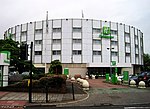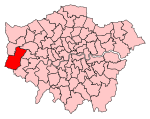Sheraton Skyline Hotel London Heathrow
1971 establishments in EnglandBuildings and structures at Heathrow AirportHotel buildings completed in 1971Hotels established in 1971Hotels in London ... and 4 more
Pages containing links to subscription-only contentQatar AirwaysSheraton hotelsUse British English from March 2017
The Sheraton Skyline Hotel London Heathrow is a 4-star, 350-room hotel, built in 1971, near Heathrow Airport in the town of Hayes, in the London Borough of Hillingdon, England.
Excerpt from the Wikipedia article Sheraton Skyline Hotel London Heathrow (License: CC BY-SA 3.0, Authors).Sheraton Skyline Hotel London Heathrow
Bath Road, London
Geographical coordinates (GPS) Address Phone number External links Nearby Places Show on map
Geographical coordinates (GPS)
| Latitude | Longitude |
|---|---|
| N 51.48153 ° | E -0.4366 ° |
Address
Sheraton Skyline (Sheraton Skyline Hotel London Heathrow)
Bath Road
UB3 5BP London (London Borough of Hillingdon)
England, United Kingdom
Open on Google Maps










